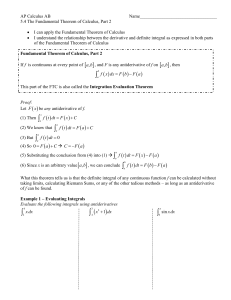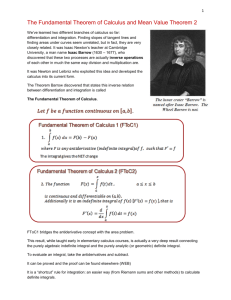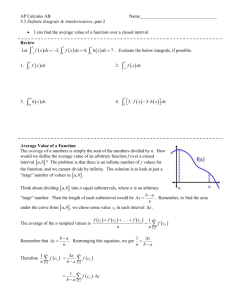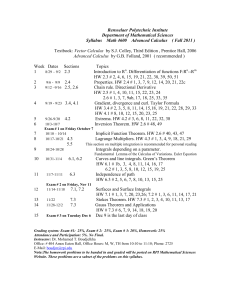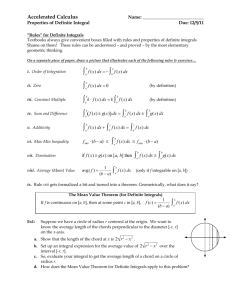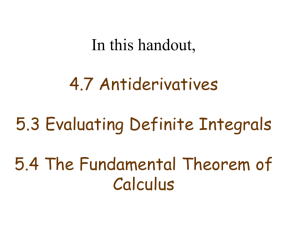Notes
advertisement
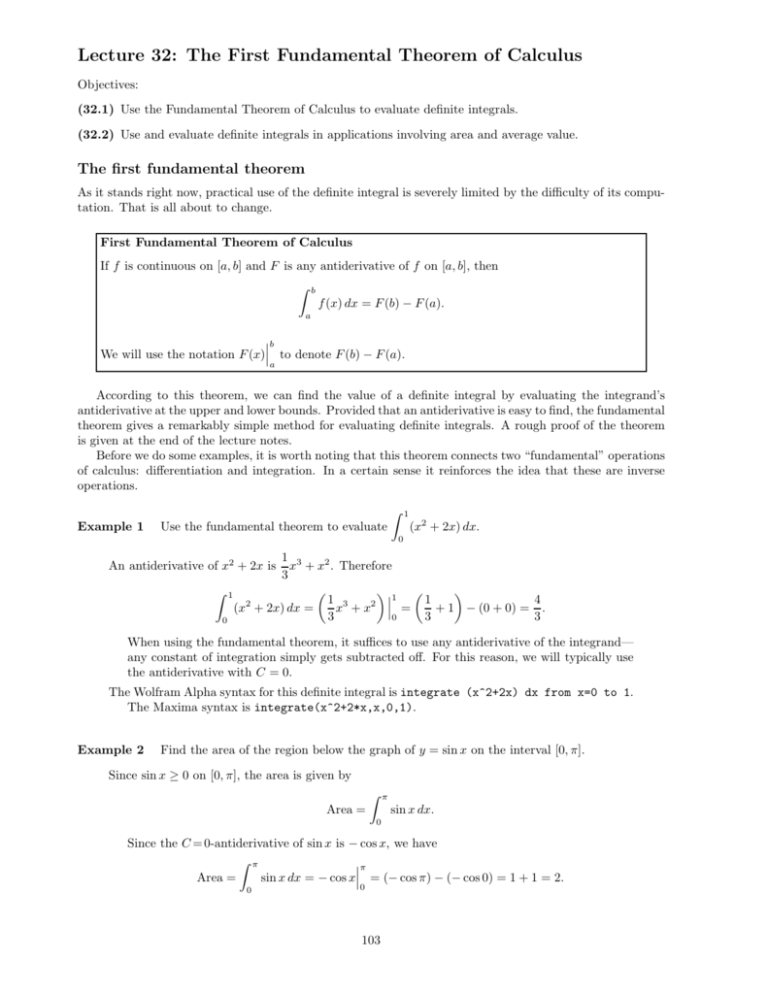
Lecture 32: The First Fundamental Theorem of Calculus Objectives: (32.1) Use the Fundamental Theorem of Calculus to evaluate definite integrals. (32.2) Use and evaluate definite integrals in applications involving area and average value. The first fundamental theorem As it stands right now, practical use of the definite integral is severely limited by the difficulty of its computation. That is all about to change. First Fundamental Theorem of Calculus If f is continuous on [a, b] and F is any antiderivative of f on [a, b], then Z b a f (x) dx = F (b) − F (a). b We will use the notation F (x) to denote F (b) − F (a). a According to this theorem, we can find the value of a definite integral by evaluating the integrand’s antiderivative at the upper and lower bounds. Provided that an antiderivative is easy to find, the fundamental theorem gives a remarkably simple method for evaluating definite integrals. A rough proof of the theorem is given at the end of the lecture notes. Before we do some examples, it is worth noting that this theorem connects two “fundamental” operations of calculus: differentiation and integration. In a certain sense it reinforces the idea that these are inverse operations. Example 1 Use the fundamental theorem to evaluate Z 1 (x2 + 2x) dx. 0 1 An antiderivative of x2 + 2x is x3 + x2 . Therefore 3 Z 1 4 1 1 3 1 x + x2 = + 1 − (0 + 0) = . (x2 + 2x) dx = 3 3 3 0 0 When using the fundamental theorem, it suffices to use any antiderivative of the integrand— any constant of integration simply gets subtracted off. For this reason, we will typically use the antiderivative with C = 0. The Wolfram Alpha syntax for this definite integral is integrate (x^2+2x) dx from x=0 to 1. The Maxima syntax is integrate(x^2+2*x,x,0,1). Example 2 Find the area of the region below the graph of y = sin x on the interval [0, π]. Since sin x ≥ 0 on [0, π], the area is given by Area = Z π sin x dx. 0 Since the C = 0-antiderivative of sin x is − cos x, we have Z π π sin x dx = − cos x = (− cos π) − (− cos 0) = 1 + 1 = 2. Area = 0 0 103 Example 3 Find the average value of f (x) = 3x2 − x + 1 over the interval [−2, 2]. Using the definition of average value from Lecture 31, we have Z 2 1 Avg = f (x) dx. 2 − (−2) −2 1 Since the C = 0-antiderivative of f is x3 − x2 + x, the average value is given by 2 Z 2 1 1 1 1 2 (3x2 −x+1) dx = x3 − x2 + x = [(8 − 2 + 2) − (−8 − 2 − 2)] = (20) = 5. Avg = 4 −2 2 4 4 −2 The Maxima syntax is integrate(3*x^2-x+1,x,-2,2)/4. √ Example 4 Let f (x) = x on the interval [0, 4]. Find a number c in [0, 4] that satisfies the conclusion of the Mean Value Theorem for Integrals. According to the MVT for integrals, there exists a number c in [0, 4] such that Z 4 √ 0 x dx = 4 · √ c. We must find a c such that √ 4 c= Z 4 0 4 2 √ 2 16 x dx = x3/2 = (8) − 0 = . 3 3 3 0 √ It follows that c = 4/3. Therefore c = 16/9. Example 5 The graph of f (x) = x5/2 − 6x3/2 + 8x1/2 is shown below. Find the area of the shaded region. 5 y 4 3 2 1 0 x -1 -2 0 1 2 3 4 Because the shaded region lies both above and below the x-axis, we cannot simply integrate f to get the area. We must separate the region into subregions on which the sign of f does not change. √ f (x) = x5/2 − 6x3/2 + 8x1/2 = x(x − 2)(x − 4) = 0 =⇒ x = 0, 2, 4. Since f (x) ≥ 0 on [0, 2] and f (x) ≤ 0 on [2, 4], we have Area = Z 2 0 f (x) dx − 104 Z 2 4 f (x) dx. 2 7/2 12 5/2 16 3/2 x − x + x , we have 7 5 3 √ 64 2 7/2 12 5/2 16 3/2 4 2 7/2 12 5/2 16 3/2 2 x − x + x (11 2−4) ≈ 7.044. Area = − x − x + x = 7 5 3 7 5 3 105 0 2 Since the C = 0-antiderivative of f is Although we could not have found the area by evaluating a single definite integral, we could have written it with a single integral: Z 4 Area = |x5/2 − 6x3/2 + 8x1/2 | dx. 0 Wolfram Alpha has no problem computing the value of this single integral. Example 6 Evaluate the definite integral: Z 3 −3 |x| dx Since f (x) = |x| is an even function, Z 3 −3 |x| dx = 2 Z 3 0 |x| dx. On the interval [0, 3], |x| = x and therefore we have Z 3 −3 |x| dx = 2 Z 3 0 |x| dx = 2 Z 3 x dx = 2 0 1 2 3 x = 9. 2 0 Justification for the fundamental theorem Suppose f is continuous on [a, b] and F is an antiderivative of f on [a, b] (i.e. F 0 (x) = f (x)). Partition [a, b] into n subintervals a = x0 < x1 < x2 < · · · < xn = b, and let ∆xk be the length of the kth subinterval. F (b) − F (a) = F (xn ) − F (xn−1 ) + F (xn−1 ) − F (xn−2 )+ F (xn−2 ) − F (xn−3 ) + · · · + F (x1 ) − F (x0 ) = = = n X k=1 n X k=1 n X [F (xk ) − F (xk−1 )] F (xk ) − F (xk−1 ) ∆xk xk − xk−1 F 0 (ck )∆xk = k=1 n X f (ck )∆xk , k=1 where ck is some point in the kth subinterval (using the Mean Value Theorem of Lecture 19). Now taking the limit as ||∆|| → 0 gives Z b F (b) − F (a) = f (x) dx. a 105


